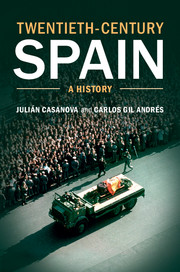Book contents
- Frontmatter
- Contents
- List of illustrations
- Key figures
- List of abbreviations
- Twentieth-century Spain timeline
- Maps
- Introduction
- Part I The monarchy of Alfonso XIII
- Part II The Second Republic
- Part III The Civil War
- 8 Spain split in two
- 9 Politics and arms
- Part IV Franco’s dictatorship
- Part V Transition and democracy
- Guide to further reading
- Index of names and authors
- References
9 - Politics and arms
Published online by Cambridge University Press: 05 July 2014
- Frontmatter
- Contents
- List of illustrations
- Key figures
- List of abbreviations
- Twentieth-century Spain timeline
- Maps
- Introduction
- Part I The monarchy of Alfonso XIII
- Part II The Second Republic
- Part III The Civil War
- 8 Spain split in two
- 9 Politics and arms
- Part IV Franco’s dictatorship
- Part V Transition and democracy
- Guide to further reading
- Index of names and authors
- References
Summary
‘We are waging war because it is being waged on us’, said President Manuel Azaña in a speech in the Valencia City Hall on 21 January 1937. It was a terrible war which in barely half a year saw the cruel terror of the rebel army and Falangists accompanied by a violent upheaval of social order. And the Republic was indeed forced to fight in a war that it did not start, and the political organisations of the left had to adapt to a military activity that they knew practically nothing about. The varying ideas on how to organise the state and society held by the parties, movements and people who fought on the republican side ostensibly played a major part in frustrating a united policy against the military rebels. And there was nothing new in this situation, as it had been going on for years and had complicated the life of the Republic in peacetime as well.
Policy and military strategy did not always coincide in the republican camp. And there was more conflict and disunity than in the Nationalist camp. Aid from the fascist powers to the military rebels was much more direct than that from the Soviet Union or the democratic powers to the republican side, and the military authorities, under the sole command of Franco, controlled the home front with an iron fist. Those who shared their values were happily experiencing the renaissance of a new Spain because their army always won its battles and so loss of morale was out of the question. For those who did not support them, a savage violence awaited them, implemented from the very day of the uprising, a violence that did not cease until many years after the end of the war. The rebels won the war because they had the best trained troops in the Spanish army, economic power and the Catholic Church on their side, and the winds of international sympathy also blew their way.
- Type
- Chapter
- Information
- Twentieth-Century SpainA History, pp. 183 - 216Publisher: Cambridge University PressPrint publication year: 2014

